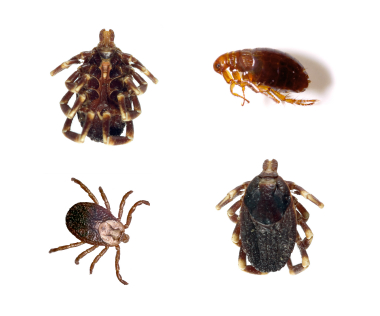Ticks can be pesky little parasites. In Southern Ontario we live in an area where there are a lot of trails with long tail grass for ticks to hide out in. If your dog spends time outside in areas where ticks like to hang out, a tick check should be part of your daily routine. Even the best tick repellents may not prevent these parasites from latching on to your pooch. Since it can take 24 to 48 hours for an attached tick to transmit an infection to its host, it is important to promptly and properly remove these parasites.
Please check your dog daily!
First, run your fingers slowly over your dog’s entire body. If you feel a bump or swollen area, check to see if a tick has burrowed there. Don’t limit your search to your dog’s torso: check between his toes, under his armpits, the insides of his ears, and around his face and chin. You should do a thorough check of your pet often, so that you get to know their normal lumps and bumps. This also gives you a guideline as to how fast any other lumps are growing.
Don’t limit tick checks to your canine family members! Ticks have been known to jump on to feline friends also. Dogs can’t directly transmit tick-borne illnesses to people, but ticks can move from host to host. A tick may enter your home on your dog or cat’s back and move on to another pet or human, or a tick could hitch a ride on you and then move on to one of your pets. A good tick prevention strategy includes checking all family members for these parasites, especially after outdoor activities in wooded, leafy, or grassy areas.
If you find a tick on your dog or cat, don’t panic! Follow these quick and easy steps to safely remove the pest.
Step 1: Get your gear
- Pair of gloves
- Clean pair of tweezers or a commercial tick remover
- Antiseptic
- Isopropyl alcohol
Step 2: Remove the tick
Wear gloves while removing the tick to avoid contact with your skin (ticks can transmit diseases to people, too).
If you’re using tweezers:
- Grasp the tick as close to your dog’s skin as possible, but be gentle! Try not to pinch your dog’s skin.
- Pull outward in a straight, steady motion, making sure that you’ve removed the entire tick, since anything left behind could lead to an infection.
If you’re using a tick remover:
- Gently press the remover against your pet’s skin near the tick.
- Slide the notch of the remover under the tick.
- Continue sliding the remover until the tick is caught in the small end of the notch and is pulled free.
Step 3: Store the evidence
Drop the tick into a small container that contains isopropyl alcohol (the alcohol will quickly kill the tick), and mark the date on the container. If your pet begins displaying symptoms of a tick-borne illness, your veterinarian may want to identify or test the tick.
Step 4: Monitor your patient
Clean your pet’s skin with antiseptic and make sure to clean your tweezers or tick remover with isopropyl alcohol. Wash your hands, also.
Please keep an eye on the area where the tick was to see if an infection surfaces. If the skin remains irritated or infected, make an appointment with your veterinarian.
Watch your pet for symptoms of tick-borne diseases. Some symptoms could include lameness, reluctance to move, swollen joints, fever, fatigue, swollen lymph nodes, loss of appetite, and neurological problems.
by Christine Attridge-Hardy




